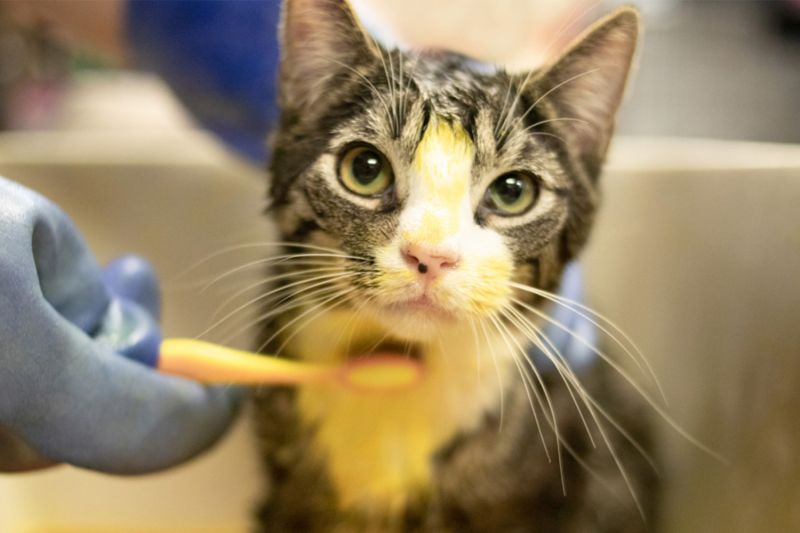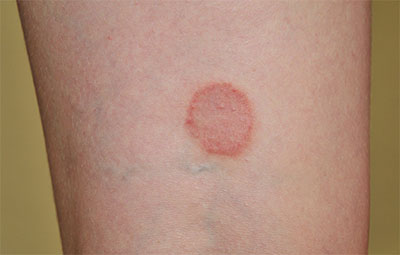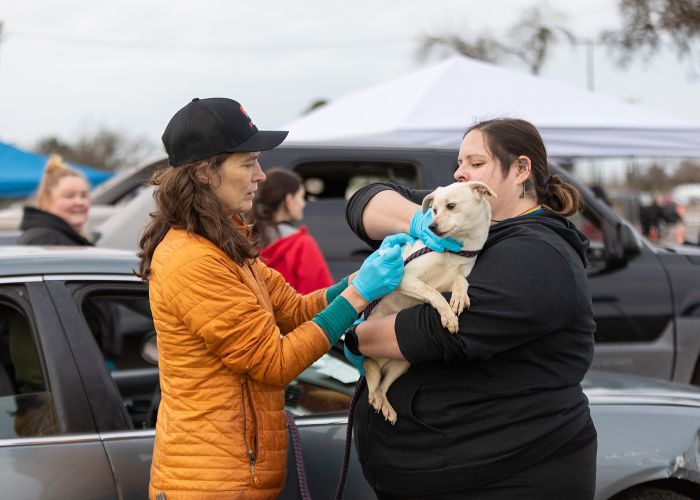Rolling with the ringworm punches
A longtime kitten rescuer’s survival guide to the dread fungus

I once had a veterinarian who liked to tell jokes.
Each time I brought in yet another kitten with ominous signs of hair loss, he told me some variation of this: “How do you get ringworm out of your barn? You burn down the barn!”
This was followed by a hearty chuckle that, truth to tell, made me want to reach out and smack my otherwise excellent veterinarian.
Ringworm has a way of killing your sense of humor. I dealt with my first litter of infected foster kittens in the mid-1990s, and for years afterwards, the sight of missing fur could trigger a minor panic attack.
Ringworm has a way of killing your sense of humor.
Over time, as I shifted my volunteer work to focus more on trap-neuter-return and less on fostering, I enjoyed a long break from the dread fungus. But TNR still brought the occasional fosters into my home, and eventually ringworm re-entered my life.
It came in the form of four 6-week-old kittens with severe upper respiratory illness, members of a feral colony I was trapping.
After two weeks in my home, they had tamed up and were over the worst of the URI. I had appointments to get them neutered and vaccinated and had already created their Petfinder profiles. My life was overloaded; I was eager to pass them on to adopters.
Then I noticed the crusty lesions along the tips of Yoda’s ears, the pea-sized bald patches on Curry’s face and tail. I struggled not to cry.
After a few deep breaths, I grabbed a beer and turned on my computer. It had been nearly a decade since my last ringworm litter; it was time to get reacquainted with my most hated fungus.
Here’s what I learned along the way:
Some things haven’t changed. One of my most salient memories of ringworm from years past was the lime sulfur dip: It smells like diesel exhaust mixed with rotten eggs. To my dismay, this was still the most effective treatment, and science has not discovered a way to mask the stink.
Another thing that hasn’t changed is the grunt work: Cleaning, disinfecting and laundry are going to be a big part of your life. (On the plus side, and contrary to what my former veterinarian used to say, you don’t have to firebomb your barn to get rid of ringworm. As Danielle Bays, senior analyst for cat protection and policy at the Humane Society of the United States, says: “The idea that ringworm will never leave your house is what we’ve burned.” And there are now healthier alternatives to bleach, as well as detailed guidelines on how to kill ringworm in everything from bedding to food dishes to carpet.)
Some things have. Several treatments I tried in the past have since been proven to be ineffective or less effective than other options. They included treatments prescribed by vets—oral Program pills, Chlorhexidine shampoo, spot-treating lesions with a topical antifungal—as well as home remedies and general tips circulating among my rescue network at the time.
Bottom line: Google will feed you an overwhelming amount of advice on ringworm. Educate yourself with the most up-to-date expert sources, ignore the rest and work with your veterinarian on a treatment plan.
Educate yourself with the most up-to-date expert sources, ignore the rest and work with your veterinarian on a treatment plan.
Catastrophizing doesn’t help. Ringworm is just a fungus, similar to athlete’s foot. So in some respects, it’s not a big deal. But it can certainly feel like a big deal if you’re already stretched to your limits.
My latest ringworm experience occurred when I had a demanding job and a long list of volunteer commitments. I lived in a small house with my boyfriend, who was undergoing chemotherapy. Two of my residents cats were FIV+, and one was in the late stages of renal disease. The last thing I needed in my life was ringworm and the extra demands of bathing cats, cleaning and laundry.

Fortunately, healthy adult animals, including humans, aren’t terribly susceptible. I’ve only had two mild cases myself, which manifested as telltale round lesions on my forearms and were easily treated with an over-the-counter topical lotion. None of my resident cats have caught it, even during the years that I was using since-debunked strategies to prevent spore transmission.
As for my boyfriend: He spent a few days feeling freaked out, but he also missed playing with the kittens. After they completed two lime-sulfur dips, he decided to chance it—and he stayed ringworm-free.
People will help. After a visit to the vet confirmed my ringworm suspicions, I thought about what the next weeks would entail, and I told my boss that I’d need to take some time off and leave work early two days a week (“dip and deep cleaning days”). Then I reached out to my rescue network for help. One friend took over my largest TNR project. Another, a former vet tech, came to my house several times a week to help with the dip treatments.
Rescue work can be challenging at the best of times, and ringworm can feel like the proverbial last straw. So let your friends, family and rescue contacts know what you’re dealing with and how they can help, whether it’s cleaning, laundry, running errands or taking on some of your other volunteer duties.
Rescue work can be challenging at the best of times, and ringworm can feel like the proverbial last straw.

Be patient. There’s still no miracle quick cure for ringworm. However, you shouldn’t underestimate adopters’ willingness to go the extra mile for an animal in need, Bays says. “Shelters are increasingly adopting out kittens with ringworm rather than keeping them for the months it may take for the fungus to clear. Adopters can do the same treatment as fosters do, and a lower stress environment is better for healing.”
At the time, it never occurred to me that I might find people willing to adopt kittens with ringworm, so I didn’t even try. I put their Petfinder profiles on hold, and in the two months it took for them to become fungus-free, they progressed from adorable fluffballs to gangly teens. But eventually the ringworm was gone, and all four boys landed in loving homes.
Yoda, now named Oscar, was adopted by a co-worker, who regularly sends me photos and updates. “He truly is the gentlest, sweetest cat I’ve ever had,” she emailed me several months ago. “He sleeps with us, loves having his belly rubbed, and he even knows how to fetch and sit on command! We love Oscar so much and he makes us smile every day.” The picture she included shows a cat with a gorgeous, shiny black coat.
The pain of fighting ringworm fades in time, but the joy of winning the spore wars endures.







